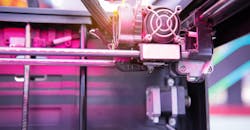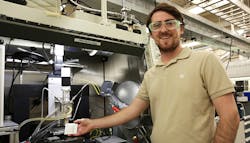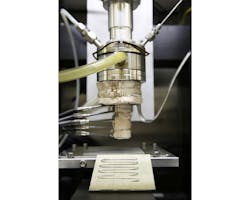Reinventing 3D Printing for Metal Parts
Researchers at the Lawrence Livermore National Laboratory, working with engineers from the Worchester Polytechnic Institute, have developed a method of 3D printing metal parts that extrudes semi-solid metal through a nozzle. They hope their new method of additive manufacturing, which they dubbed direct metal writing, will create metal parts without the gaps and other defects found in parts made using selective laser melting (SLM)—currently the most popular method of printing 3D metal parts. It uses lasers to fuse layers of fine metal powders.
The new process starts with an ingot of specially engineered metal that is a mixture of bismuth and tin. The material is shear thinning, which means it is solid at rest, but when it moves or is in shear, it acts like a liquid. The ingot is heated until it is in a semi-solid state with solid metal particles suspended in liquid metal. This paste-like metal is extruded through a nozzle and hardens as it cools. Researchers have already been able to 3D print self-supporting metal structures in the lab.
The team still has several challenges to overcome before a printer is commercially viable. The nozzle must be refined, so as to get the process working with more industry-friendly metals like aluminum and titanium. But those metals have much higher melting temperatures (660°C for aluminum, 1,668°C for titanium) than the bismuth-tin mixture which melts at 300°C. The team also needs to determine what exactly is happening inside the nozzle so they can refine it. Currently, metal forms dendrites that get stuck inside the nozzle during extrusion.



